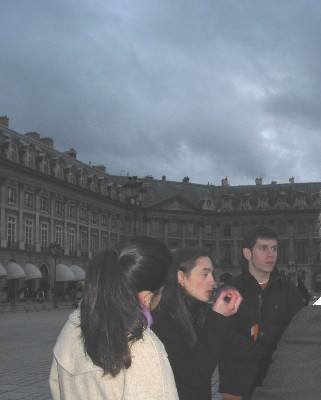Arc de triomphe du Carrousel
Place du Carrousel. 1e arr.
Métro: Palais-Royale Musée du Louvre (1, 7)
In the same year that he commissioned the Arc de Triomphe (1806), Napoléon also commissioned the Arc de triomphe du Carrousel, located between the Louvre and the Tuileries. Modeled after the Arc de Triomphe de l'empereur Septime sévère in Rome, the arc consists of three arches, one large center arch and two smaller side ones. The statue on top is a replica of the original statue, which was taken from Venice and returned in 1815 during the Austrian occupation of Paris. The whole structure measures about 20 meters high and 23 meters wide, making it much smaller than the Arc de Triomphe, with an inverse proportionality (slightly wider rather than slightly taller). According to a Parisian taxi driver, the size of the Carrousel arc was used to create the illusion of greater distance when viewed from the Arc de Triomphe. Since both arcs are part of the Grand Axis of Paris, the view is only obstructed by the Obélisque de la Concorde and continues past the Carrousel to the glass pyramid and the rest of the Louvre castle.
Pont-Neuf
Adresse : Pont Neuf. 1e, 6e arr.
Métro : Pont-Neuf (7)
Despite its name, which means brand new bridge, the Pont-Neuf is actually the oldest bridge in Paris. At the time that it was built, the Pont-Neuf marked a new style of bridge. Before it was built in 1584, all the bridges crossing the Seine were covered on both sides by houses packed together becaus Parisians thought that the houses would help prevent the bridges from falling down in the currents. Henri IV envisioned a different kind of bridge, one that would connect the important Île de la Cité to both the right and left banks, with a picturesque view of the Seine, unhindered by any buildings.
At the center of the bridge is a large equestrian statue of Henri IV, originally constructed under the orders of Marie de Medicis, Henri’s widow, in 1614. It was rebuilt in the early 19th century when the monarchy was reinstated after the revolution. The new statue was made by melting two statues of Napoléon and using the original cast. Inside the statue, the new sculptor Lemot put four boxes, containing a history of the life of Henri IV, a 17th century parchment certifying the original statue, a document describing how the new statue was commissioned, and a list of people who contributed to a public subscription. During a restoration of the statue, three small wooden cylinders were discovered, containing documents of unknown origin.


Place Vendôme
Adresse : place Vendôme. 1e arr.
Métro : Opéra (3, 7, 8)
When Louis XIV wanted to make a royal place to show off his power, he wanted it to be huge. Unlike Henry IV, though, who designed every detail himself, Louis XIV left the details up to his architect, Mansart. After an initial conception as a square, the final design was changed to an octagon, with large street openings on either side to give a slightly more open feeling to the place. The enormous size adds to the feeling of openness, allowing much more light inside than the smaller Place des Vosges. The buildings around the octagon all have a uniform appearance on the outside, but not on the inside. Since King Louis was only interested in the outer appearance, Mansart left the inside empty, letting the new occupants choose the interior decoration. As a result, no two apartments are the same.


The statue that was originally in the center of the place Vendôme was, not surprisingly, one of Louis XIV on a horse, dressed in roman attire to symbolize his power. The statue was destroyed during the Revolution along with almost all the royal statues in Paris. In the beginning of the 19th century, the Vendôme column took its place in the center, under the orders of Napoléon. The column mimicked roman columns, recounting Napoléons victories spiraling up the bronze column, leading to a statue of Napoléon himself, dressed in Roman attire. As the column was once again seen as a symbol of the monarchy, it was taken down four years later, put back by Napoléon III, destroyed in 1871, and finally replaced in 1875. Today the place Vendôme remains an open square with lots of space for pedestrians in the center and cars driving around the outside.
